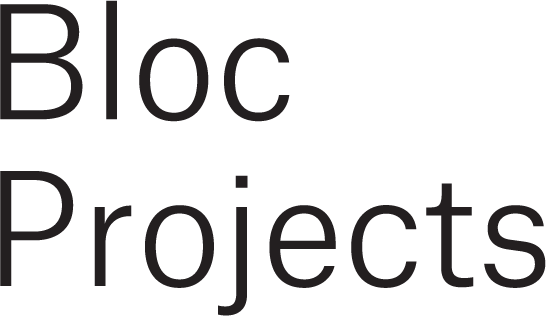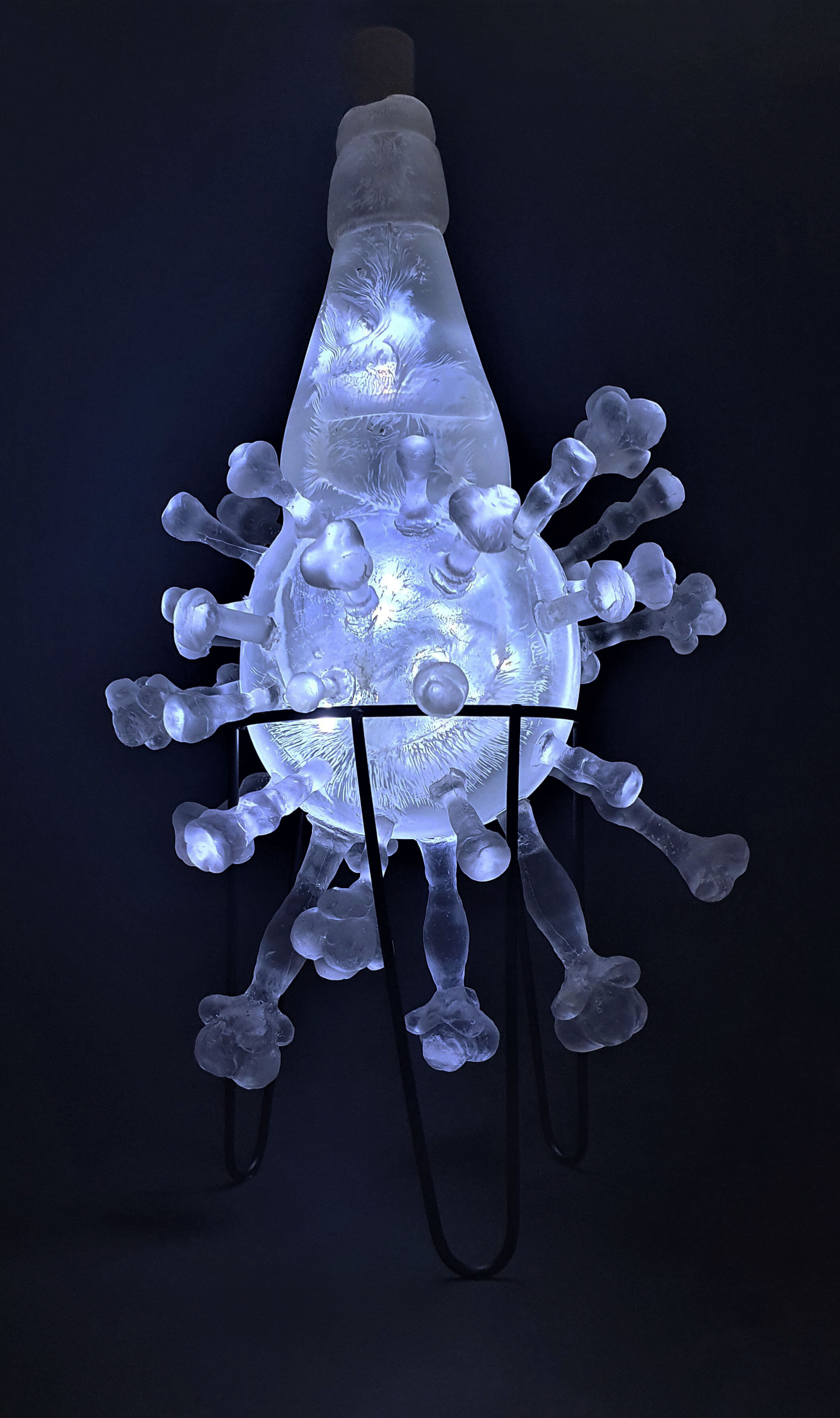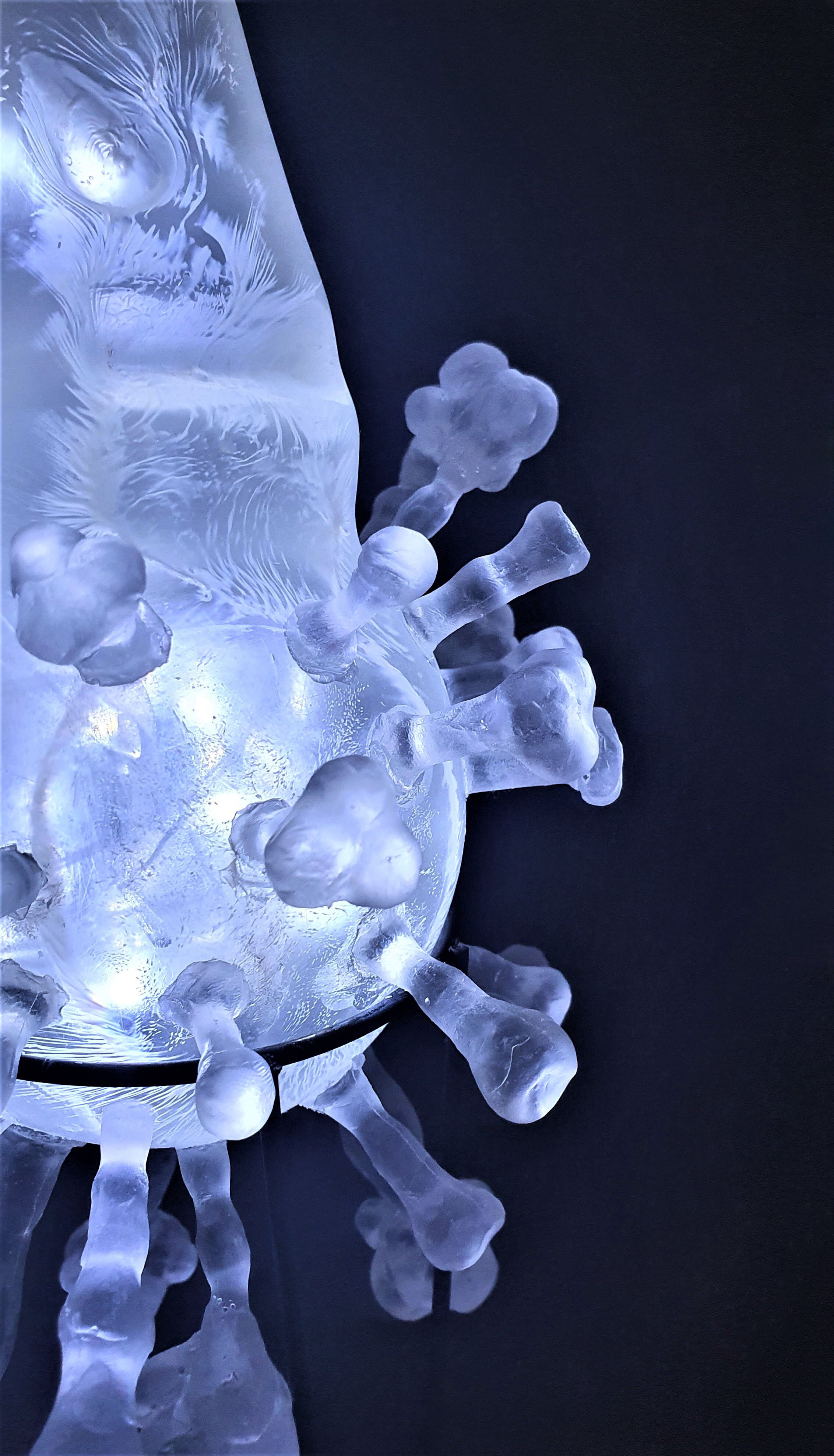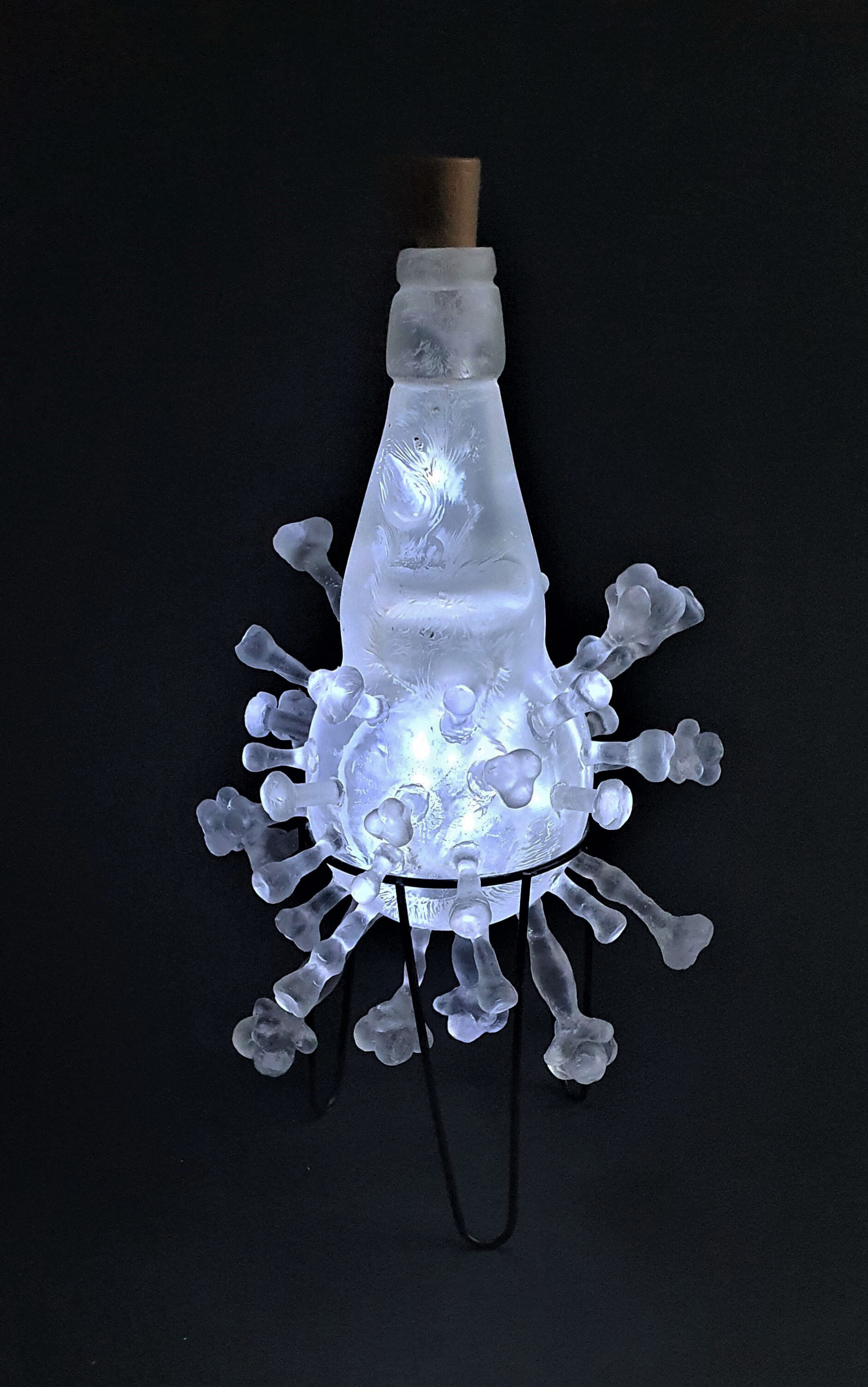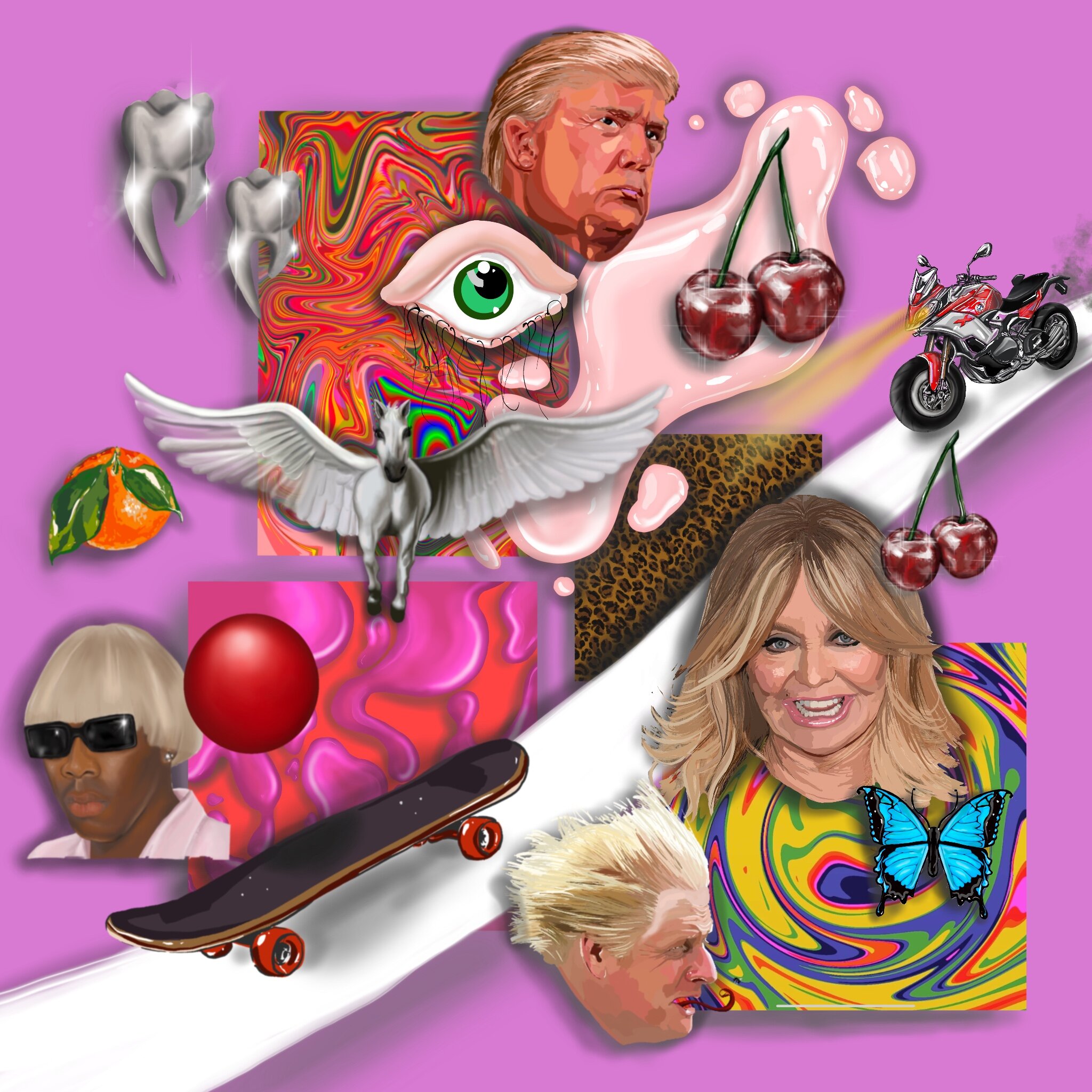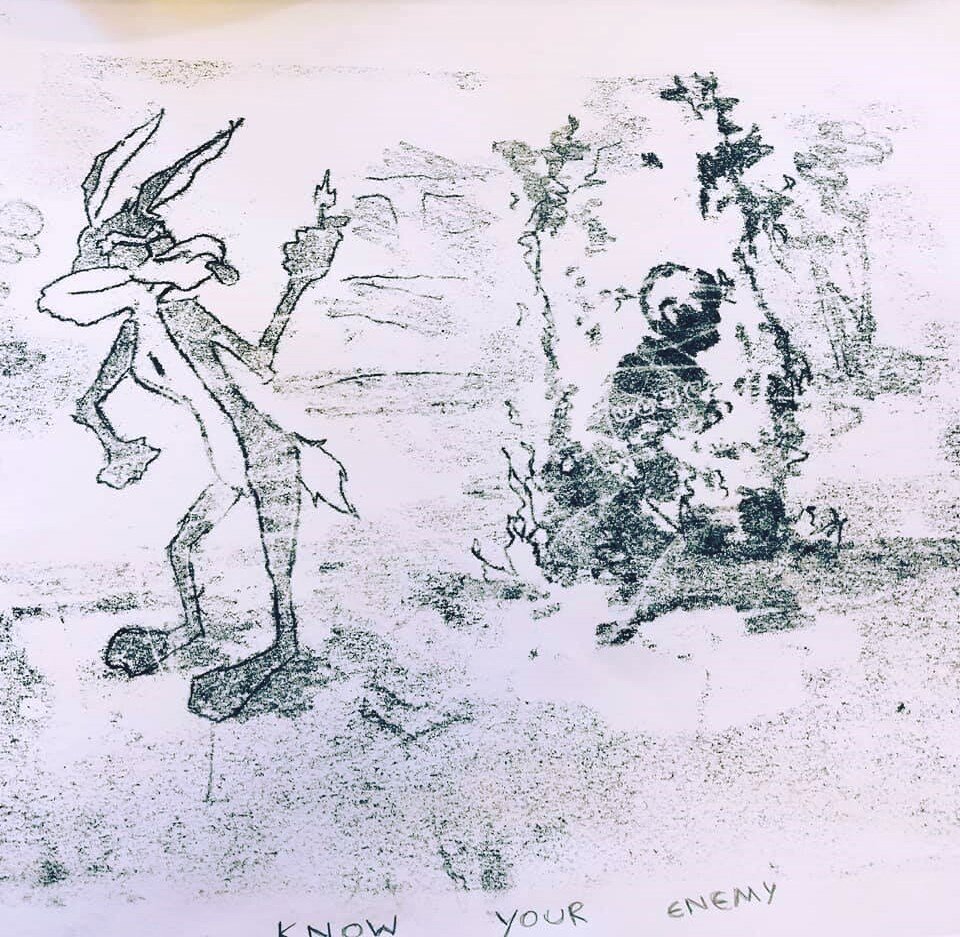Turbulent Times
15 January - 28 February
Online Exhibition
Anya Austin
Asfa Hussain
Bethan Hurford
Delyth Barlow
Elizabeth May Barlow-Hall
Hope Schofield
Jade Buchan
Lauren Blendell
Linda Cassels
Russell Jones
Seren Lewis
Sue Hare
Zoe Palmer
Turbulent Times is an exhibition of new work by second year Fine Arts Students from Sheffield Hallam University.
The works in this online exhibition reflect on some of the defining moments of 2020, including the COVID-19 pandemic, the urgent ‘call to action’ of movements like Black Lives Matter, and the struggles against oppressive systems of governance in recent contemporary history. Some of the works also offer hopeful glimpses both admist and beyond trauma, shaping different temporalities to work through past, present and future anxieties and injustices.
More information about the artists can be found towards the bottom of the page.
Mayday, photographs, dimensions variable
Anya Austin
Mind on Fire, painting on A4 paper
Asfa Hussain
Joined?, quilt, 66 x 108cm
Bethan Hurford
Containment, sculpture, 37 x 20 x 18 cm
Delyth Barlow
Quarantine, digital print, 180 x 90cm
Elizabeth May Barlow-Hall
Rematerialisation of the sex object, film
Hope Schofield
MONEY LOVE DEBT, photographs, 42 x 59cm
Jade Buchan
2020 Vision, digital collage, QR code and animation
Lauren Blendell
I Stand, film, photograph, sculpture and collage
Linda Cassels
Lamentations
(from left to right)
Wile E. Coyote and the Buddhist Martyr , monoprint, A3
Neues Folk, pastel, A3
The Grand Wizard of Bahia de Guantanamo, monoprint, A3
Russell Jones
howtomeetnewpeopleinapandemmic, film
Seren Lewis
A myth cannot possibly evolve from the nature of things, (top) 9 embossed writings, 200 x 37 cm, (left) file boxes and embossed writings, 53 x 71 cm, (right) detail of box file ends, 53 x 71 cm
Sue Hare
Satellite-Cell, digital collage, 10 x 15 cm
Zoe Palmer
Anya Austin
2020 has been a difficult time for us all, full of isolation and closure of everyday life. For this reason, I wanted to highlight the changes that have become routine since the pandemic, specifically the use of face masks as the debate has been something of a conversation point since the first signs of COVID-19.
I titled my piece ‘Mayday’ which is a word used to warn others of life-threatening emergencies. It originates from the French word “m’aider” which means “help me”. The photography piece shows different subjects each wearing a different face mask. The black and white photography suggests feelings of isolation while the quotes on the mask are coloured to highlight their importance. The quotes are in reference to the newspaper articles written during the 1918 Spanish Influenza.
The Spanish Influenza affected 500 million lives with an unknown death rate predicted at 20 to 50 million. People wore face masks, much like the ones we use today. Those who protested cut holes in their masks in order to smoke and often ended up with a fine or sometimes were named and shamed in their local newspaper. With underdeveloped medical sciences, there was no sign of a vaccine which meant that people had to follow guidelines to survive. Today we have the capability and knowledge to tackle COVID-19 yet some members of the public chose to ignore medical advice. As the fight continues, we watch to see whether COVID-19 or human arrogance will prevail.
Asfa Hussain
Art is a therapeutic way to escape from reality and helps you to de-stress and gather your thoughts. I wanted to focus my theme on a topic which was relatable to me personally and something that a lot of other people around the world would be going through in these unprecedented times. Millions of people have lost their lives to COVID 19 and others have been affected directly or indirectly. This may have had an affect on our mental health and even made us paranoid to leave our homes. Other people have fell into depression due to lockdown as they have not come into contact with their loved ones due to restrictions. Lack of socialisation is a big reason why people are unable to distract themselves from intrusive thoughts and personal problems. I think mental health should be normalised and people should not be outcasted for or ashamed to show their emotions.
My piece of work is a depiction of the mind of a person with mental illness. The messiness and abstract style shows the intrusive thoughts of the mind which can spread and become uncontrollable if not contained. This is also the reason for the use of orange which represents fire; a known cause of chaos and havoc.
One artist which has inspired my work is Vincent Van Gogh. He is a famous artist who suffered from mental illness. Van Gogh did not get the recognition he deserved while he was alive and only sold one painting in his entire life. He became famous after his death. ’Starry Night’ was arguably Van Gogh’s most famous artwork which was painted in an asylum. This illustrates that beautiful art can still be created no matter what the atmosphere and the situation may be.
Bethan Hurford
During the first Coronavirus lockdown we faced in the UK, I took the time to learn to sew by making face masks for my local community. The skills I learnt through this process have inspired much of my current practice, using my remnants to establish fabric as Fine Art. I wanted to create a piece of work to act as a memorial for all we have faced this year, and to pay tribute to those who have lost their lives and those who fought to save them. My work takes the form of a quilt wall hanging, featuring many different themes that have arisen during the pandemic. Amongst these themes are union and home as well as hope which takes the form of the rainbow symbol, which brought the nation together. A quilt is homely and safe which we often use for comfort. ‘Joined?’ subverts this comfort, adding horror as it references a deadly virus. This juxtaposition is relevant in the way many of us felt whilst being at home; we were safer, but we did not necessarily feel safe. The Michelangelo inspired imagery features mine and my boyfriend’s hands as we were separated not only by the national restrictions, but also by shielding. This separation is strengthened by the handmade nature of sewing which suggests the sensation of touch that we have all been lacking. I hope people can relate to the work in the same way I do and use it for reflection and memorial.
Delyth Barlow
My practice takes a critical view of health, history, society and how people are affected by events. I work with these themes as they contain information that we could learn more from. My current focus is the coronavirus pandemic.
My work consists of sculpture, casting, painting, and drawing. I began my coronavirus work with scientific diagrams of the Covid-19 molecule; I saw beauty within the molecule that I could utilise. Like Helen Chadwick, I want to turn a topic with negative connotations into something beautiful and bring joy to an otherwise distressing time.
However, I also want to show the pressure coronavirus has created by combining the molecule with a bottle. I used Codd bottles (early pressurised drink bottles) due to their association with pressure and containment. The bottle is 3D to give it a tactile nature, something you want to hold but are unable to, much like how we currently feel with loved ones. The clarity of the bottle, combined with the effect of light, recalls the beauty of glass but also creates tension between the bottle and its subject matter, as in Luke Jerram’s Glass Microbiology. The clear resin also makes the work seem fragile, like the world around it. Filling the bottle with light reveals the flaws in the resin and highlights the feeling of containment that accompanies Covid-19.
I want the work to question the world around it; how we react to a crisis and how the crisis affects people.
Elizabeth May Barlow-Hall
Quarantine is one of a series of photo-text works employing ink-blooms and codewords drawn from archival sources such as the ABC Universal Electric Telegraph Codebooks from the late 1800s. Quarantine and its related body of work are not intended to be fixed, either in themselves (new versions may be made) or in their relation to each other.
I am interested in what happens when image is combined with text. Does the text operate to give the image ‘meaning’ or does the text strip ‘meaning’? Is the text disposable or necessary to draw viewers in?
This is a piece that seeks to test the viewers’ engagement with what they see. The text stands out, capturing the ink-bloom and acting as a connection between it and the audience. This connection explores the human desire to read and understand what is presented. When given the image it could easily be ignored as just an image, but when given a line of text (or a single word) will the audience automatically read it and connect with the piece?
In some senses the work reflects and addresses the current pandemic. The 'perceived' fixity of the text traps the image; a possible metaphor for lockdown. The confusion over what is being said by the image also mirrors my confusion in regard to messages from authority. Ever-changing tier systems and honey-coated truths are reflected in words like “Longtail” and “Quest” which by the 4th edition telegram codebooks represent “Lock- out” and “Quarantine”.
Hope Schofield
Heavily influenced by Marxism and the theories of Art critic Lucy Lippard I work within a dematerialised practice, film, as a means of confronting the material alongside material production and ideas surrounding labour whilst maintaining a level of disconnection. The seemingly glaring hypocrisy of using, as a subject, the avoidance of the commodity and industrial manufacturing all while being unable to dodge the commodity through the use of apparatus, props, actors, and the sculptural techniques I use within those subsections, is actually, bizarrely, what I want.
Utilising garish pinks and kitschy aesthetics to present a camped up, vulgar representation of otherwise bleak and/or gory processes; armed with a distastefully literal interpretation of ‘fetishisation of the object’, I try to present Marxist theories as well as issues of gender and sexual politics in the same manner as a busty dinner-lady slopping your plate with questionable mush, leaving you to decipher the contents.
Jade Buchan
Throughout this project I have been exploring my own and others views about money and how money has an impact on everyone’s lives, how it determines who we are as people and the type of life we will lead. This project has shown my own journey of understanding the concept of money. It seems that money has control over so much of our lives that we cannot escape from, making it a daunting aspect of our lives. I am influenced by Sharron Farrelly and Ben Rider, who create statement pieces using typography within their work and using what is in the media and their own views. This influenced my work by making me more confident in including my own thoughts whether they are personal or not. Also, I started to look at what colours I wanted on the poster and what works well together. I started off with dark colours then bright colours, which I have used throughout my work, from the posters to the clothes. The finale piece MONEY LOVE DEBT uses the word debt over and over, making it stand out and indicating that money isn’t always so glamorous or positive. The work also looks into ideas of greed and the negative side of money; a smart shirt that has been ruined by greed. This project has opened my eyes with the different options in life where money isn't the main way to have a happy life.
Lauren Blendell
I am obsessed with chaos and collecting and hoarding things. I feel my work is an outlet for the chaos in my mind. I have found that collage is an effective way of representing this.
There is also a growing presence of politics within my work as I feel it is more and more difficult to ignore the politics of the world when there are so many unjust and baffling things occurring. They are the things that we talk and think about the most and so I feel that although it would be beneficial to myself to have a practice which is an escape to this madness, I think what is needed at the moment, is artistic representation of things to document and also bring the issues into the industry as we can create extremely effective and emotive work that could influence the world. I feel it is so important that we are working with current affairs and not just sticking to our own.
We’ve all lived through 2020 and all had our own experiences- no one needs a telling of this. I have watched Goldie in Death Becomes Her more then I care to reveal, watched as world leaders make decisions that change and end the lives of many, stared at the ceiling until patterns appear in lockdown and spent the majority of my time looking at screens so it is only right that my work is also digital.
lauren-bellendell.webnode.co.uk
Linda Cassels
My work centres around (my own) identity, the development thereof, and what influences one’s view of oneself around the issues of migration. Humanitarianism: race, culture, class, and democracy are things I question. This has led to me asking myself; what influences the individual’s perception of society? Does the body have a purpose other than to contain the soul? If not, are the contents of the vessel more important than the vessel itself?
Classical sculptures were used as a means to narrate stories of the past and to influence the individual’s perception of society. Classical sculptures tend to be colossal in size. Confronted by these massive sculptures, their posture and stature convey their dominance since we involuntarily have to interact with them. As a method of conveying my concerns surrounding humanity, I wanted to re-enact classical sculpture in the project, I Stand
During the conception of this largely abstract project, I use video, sculpture, photography, and poetry as a way to convey my message. In I Stand, I use shape and form alongside a limited achromatic colour palette with pops of colour in order to explore my questions surrounding identity.
Identity is formed by different aspects of socialisation and the values adopted by the individual. For example, a person's identity can be shaped by culture, fashion, etc... Clay, like the nature of a person’s identity, is pliable and elastic and therefore has an innate ability to transform into something else. I decided to experiment with clay for this reason.
If you take away aesthetics and refinement from a clay vessel, the purpose of the vessel is to hold something. Likewise, if you strip someone from their physical profile, it is the soul that remains. The body functions then as a vessel for the soul and this is where our emotions and feelings are moulded. The body, therefore, is the conduit for the soul - as the vessel to the content that is in the vessel.
Overall, the works of Tom Hunter, Magdalene Onduno, Martin Creed, Socrates, Marc Quinn, Shoji Hamada, Wabi Sabi, Zanele Muholi and Beyonce, inspire me to be more introspective when looking out at the world.
Russell Jones
Lamentations 5:7 - Our ancestors sinned and are no more, and we bear their punishment. A triptych on the futility of war.
1: Wile E. Coyote and the Buddhist Martyr (Monoprint) - The self-immolation of a Buddhist martyr and the noble sacrifice sabotaged by the involvement of an American cartoon icon.
2: The Grand Wizard of Bahia de Guantanamo (Monoprint) - The Grand Wizard is detained on allegations of terror and still refuses to reveal his identity.
3: Neues Folk (pastel) - German women played a vital role in the Nazi movement, one which far exceeded the Nazi Party’s propaganda that a woman’s place was strictly in the home as mothers and child-bearers. Of the estimated forty million German women in the Reich, some thirteen million were active in Nazi Party organisations that furthered the regime’s goals of racial purity, imperial conquest, and global war.
Seren Lewis
This video piece shows the journey of development in my work looking into how we can connect and meet new people whilst isolating in a pandemic. Experiences of making remote relationships, over the internet and mobile devices. Thinking of how we interpret and translate online messages, especially as an autistic person and talking to people with different mother tongues. No matter how near or far people are, in isolation, every new relationship is a long distance one.
I was inspired by old Lesbian love letters, such as those written by Violet Trefusis and Vita Sackville-West. The thought of much needed covertness, hidden messages and secret coded languages. Queerness and code seem to have a symbiotic relationship and, as someone who enjoys learning how to programme, I looked into Alan Turing, cryptography, ciphers and code-breaking.
I am particularly drawn to the aesthetics of code and am fascinated by language, which led me to investigate Concrete Poetry, a language-based art, where text and symbols are used primarily as a visual medium.
I started to use HTML, CSS and JavaScript to experiment making art works that could either be animated or interactive in some way. The aesthetic is moving more into the themes of technology, glitch and coding. With an idea of building my own website for users to explore this project freely, I hope to develop it into something that can be used to communicate with each other. The internet is ours and is needed more than ever right now.
Sue Hare
My interests are driven by aspects of life which are not easily seen, especially those deliberately hidden, ignored, lost in history, or hiding in plain sight. This unusual year led me to research the persistence of racist myths. Barthes tells us “a myth cannot possibly evolve from the ‘nature’ of things’” and Holzer reminds us that “all things are delicately interconnected”. They encapsulate my experience of 2020, whose speech and language are fascinating. Collected words related to Covid 19 and Black Lives Matter (BLM), such as, bubble, trust, excess deaths, furlough, tiers, herd immunity, topple, science, identity, inequality and white privilege, led me to focus my enquiry on white privilege and inequalities. I also explored the white aesthetic and the nonsense of superiority measured simply by whiteness, skin colour, birthright, inheritance, or gender. My work, meant to be touched and handled, is experimental and conceptual, based on language, and seeks to prompt questions. The method I settled on—embossing words into paper by hand—is a way of reducing the capacity to rub out or hide from truths rather than live within myths. I wonder whether, once the vaccines have been received, BLM will go back into the archives as in previous years; and will identity politics and the continuing impacts of colonialism be reimagined by the powerful as myths? Barthes says that myths are carried in speech and language – in Marx’s terms ideology. I take from this some hope and agency: since nothing is fixed, good change can happen for humanity’s sake by seeking truths.
Zoe Palmer
During the first part of the lockdown in March, the year 2020, I felt like the walls were closing in and the screens on my devices getting bigger!
Millions of people, for the best of reasons, were trapped indoors and probably spending more time on their devices too.
What were some of the negative and positive implications of this?
This question was the foundation of my own inquiry and upon this path I encountered a book called “The age of surveillance capitalism” by Shoshana Zuboff. I learned that the amount of behavioural data being extracted from the population via digital surveillance is phenomenal. The information that is harvested from this is very often used for monetary gain. I found this fascinating and yet, simultaneously terrifying because these implications can have a direct impact upon a populations freedom of will. This notion inspired me to create Satellite-Cell.
For a long time, I had wanted to learn the very basics of Adobe Photoshop to help me visualise, develop and create my images. Before the pandemic I enjoyed different methods of print making but mainly silk screen printing. I realised that learning how to create digital images would only enhance my print making skills. I saw it fitting that as I learned about the negative aspects of a digitised society, I would learn the basics of a new digital skill.
